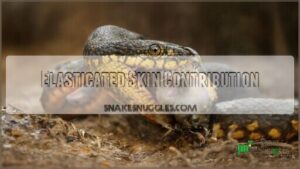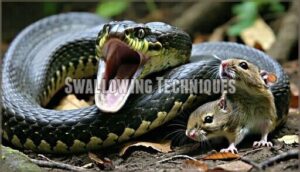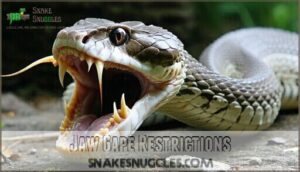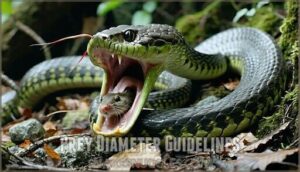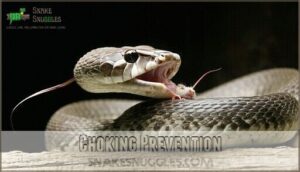This site is supported by our readers. We may earn a commission, at no cost to you, if you purchase through links.
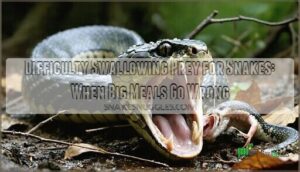
Your snake’s remarkable jaw anatomy allows it to tackle prey wider than its head, but there’s a breaking point.
Overly ambitious meal choices can lead to regurgitation, choking, or dangerous impaction.
The culprit often isn’t just size—it’s timing too.
Handle your snake too soon after feeding, and you’ll likely see that expensive meal come right back up.
Temperature, stress, and prey preparation all play key roles in successful feeding.
Understanding your snake’s specific limitations prevents costly veterinary emergencies and keeps your serpent healthy and satisfied.
Table Of Contents
- Key Takeaways
- Snake Jaw Anatomy
- Swallowing Techniques
- Prey Size Limitations
- Feeding Challenges
- Digestion Process
- Overfeeding Risks
- Safe Feeding Practices
- Choking Prevention
- Snake Health Management
- Frequently Asked Questions (FAQs)
- What to do if my snake is struggling to eat?
- How does a python ensure it doesn’t suffocate while swallowing large prey?
- Can snakes dislocate their jaws to swallow prey?
- Can snakes choke on water while swallowing?
- Do temperature changes affect swallowing ability?
- How do injured snakes manage prey consumption?
- Can snakes swallow multiple prey items simultaneously?
- What happens when snakes eat poisonous prey?
- Conclusion
Key Takeaways
- Size your prey correctly – Don’t exceed your snake’s widest body diameter to prevent choking and regurgitation incidents
- Use pre-killed prey – You’ll eliminate dangerous struggles and awkward positioning that can block your snake’s airway during swallowing
- Monitor temperature and timing – Keep your enclosure warm and don’t handle your snake after feeding, as both affect digestion and can trigger meal rejection
- Watch for warning signs – If you notice stuck prey, labored breathing, or hindquarter paralysis, contact a reptile veterinarian immediately before the situation becomes life-threatening
Snake Jaw Anatomy
You’ll find that a snake’s jaw isn’t actually "unhinged" like many people believe, but instead relies on incredibly flexible ligaments connecting two separate mandibles at the bottom of their mouth.
The quadrate bone acts as a mobile hinge point while elasticated skin around the head and neck stretches dramatically to accommodate prey that can be up to 149% wider than the snake’s head.
Flexible Ligament Connection
Unlike mammals, your snake’s lower jaw contains two separate mandibles connected by an elastic ligament rather than fused bone.
This flexible jaw structure allows independent mandible movement, creating the remarkable jaw flexibility that enables your snake’s swallowing mechanism.
The elastic connection stretches substantially during feeding, permitting the jaw ligament to accommodate prey much wider than the snake’s head through coordinated mandible movement and ligament structure expansion.
Quadrate Bone Mobility
The quadrate bone acts as your snake’s secret weapon for jaw flexibility.
The quadrate bone serves as nature’s ultimate jaw hinge, unlocking incredible feeding potential.
This highly mobile bone structure connects the lower jaw to the skull, enabling the dramatic cranial movement that makes swallowing large prey possible.
When your snake prepares to feed, the quadrate bone functions as a hinge mechanism, allowing each side of the jaw to dislocate and move independently during the swallowing process.
Here’s how quadrate bone mobility transforms your snake’s feeding abilities:
- Lateral movement expansion – The bone pivots outward, widening the jaw structure beyond normal limitations
- Independent jaw control – Each quadrate bone operates separately, creating asymmetrical jaw movements
- Cranial flexibility enhancement – The mobility mechanism allows the entire skull to adjust during feeding
- Snake evolution adaptation – This specialized bone structure developed to maximize prey size intake
- Swallowing mechanism coordination – The quadrate bone synchronizes with other jaw components for efficient prey manipulation
This remarkable bone structure represents millions of years of evolutionary refinement, giving your snake the ability to tackle prey that would be impossible for rigid-jawed predators.
The snake’s ability to stretch its jaw is made possible by its unique jaw dislocating mechanism.
Elasticated Skin Contribution
Your snake’s elastic skin works like a natural rubber band around the head and neck, stretching dramatically during cranial kinesis to accommodate prey much larger than normal gape limitation would suggest.
This skin stretch partners with jaw flex and elastic ligament connections, allowing successful prey ingestion even when swallowing difficulties might otherwise occur during snake digestion processes, which involves a complex interplay of elastic ligament connections.
Swallowing Techniques
You’ll observe three distinct mechanisms that allow snakes to consume prey much larger than their head diameter.
These coordinated swallowing techniques work together to guide massive meals down the snake’s throat through a series of ratcheting movements and muscular contractions.
Jaw-Walking Method
Once your snake’s jaw anatomy enables the wide gape, the jaw-walking method becomes the primary feeding technique for prey ingestion.
You’ll observe alternating jaw movement as one mandible grips while the other advances forward.
This snake flexibility allows mouth expansion through coordinated macrostomatan jaw mechanics.
The jaw walking process creates a ratcheting motion that pulls prey deeper into the throat, making snake swallowing possible even with oversized meals.
Pterygoid Walk Movement
During jaw movement, you’ll observe the pterygoid walk as upper tooth rows move independently through ratchet mechanism sequences.
This macrostomatan jaw adaptation involves streptostylic quadrate bones enabling cranial kinesis without true jaw dislocation.
Through coordinated muscle coordination, each pterygoid bone alternates forward movement while maintaining grip on prey.
This specialized tooth action facilitates prey ingestion by creating systematic advancement toward the throat opening, which is a result of the cranial kinesis.
Peristaltic Contractions
Once your snake’s jaws have positioned the prey using pterygoid walk movements, powerful muscle waves take over the feeding process.
These peristaltic contractions create a coordinated digestive rhythm that propels food down the esophagus through systematic esophageal movement.
The glottis function remains active during this food propulsion, preventing snake swallowing problems and digestive issues throughout prey consumption.
Prey Size Limitations
While snakes can open their mouths impressively wide, the actual limiting factor for prey size isn’t jaw gape but rather the width of their buccal cavity and throat.
You’ll find that even with their remarkable jaw flexibility, snakes still face physical constraints when attempting to swallow prey that exceeds their body’s widest diameter, which is a significant constraint.
Buccal Cavity Width
Width matters more than you’d expect when your snake attempts to swallow oversized prey.
The buccal cavity’s diameter sets the real limit for what fits through your snake’s mouth opening.
Burmese pythons can expand their cavity size four times wider than their skull, creating impressive jaw expansion.
However, prey diameter that exceeds this swallowing capacity leads to serious swallowing problems, forcing your constrictor to abandon meals or risk dangerous blockages in their jaw structure.
Understanding the python feeding mechanism is vital to grasping the nuances of snake anatomy and behavior.
Jaw Gape Restrictions
Despite their remarkable flexibility, your snake’s jaw structure has inherent bone structure limitations that affect mouth capacity.
Gape mechanics depend on specific anatomical boundaries that create flexibility issues during feeding attempts.
- Supratemporal and quadrate bones dictate maximum jaw limitations
- Mandible separation reaches physical limits based on ligament elasticity
- Skull width restricts how far jaw bones can spread laterally
- Snake anatomy prevents unlimited mouth opening despite popular myths
- Swallowing problems occur when prey exceeds these mechanical boundaries
The limitations of a snake’s jaw structure are critical to understanding its feeding behavior, and recognizing the anatomical boundaries and mechanical boundaries is essential for appreciating the challenges snakes face when consuming prey.
Prey Diameter Guidelines
How exactly should you determine proper prey size for your snake?
Feeding guidelines recommend prey diameter shouldn’t exceed your snake’s widest body section. Most reputable sources suggest prey ranging from equal to 1.5 times your snake’s girth, with anything larger increasing choking risk and regurgitation.
Weight-based rules offer additional safety, targeting 10-15% of your snake’s total body weight per meal. These feeding limits help prevent dangerous swallowing capacity issues.
To guarantee the best results, consider consulting snake feeding guides for more detailed information on proper prey size and feeding techniques.
Feeding Challenges
Even with their remarkable jaw flexibility, snakes sometimes face serious feeding challenges when prey exceeds their physical limits.
You’ll witness stuck prey, dangerous regurgitation episodes, and potential choking hazards when snakes attempt to swallow meals that are too large for their anatomy.
This can lead to severe consequences, but the primary issue revolves around the snake’s inability to properly consume prey.
Prey Getting Stuck
When prey gets stuck, you’re facing a serious emergency that requires immediate attention.
When feeding goes wrong, your snake’s life hangs in the balance.
Legs can splay outward during swallowing, creating airway obstruction and choking risk.
Frozen-thawed prey with stiff limbs increases stuck prey incidents, while improper prey size selection leads to feeding issues.
Emergency care becomes necessary when swallowing disorders persist, as manual prey removal may prevent fatal outcomes, which is a critical step in handling stuck prey incidents.
Regurgitation Risks
When oversized prey encounters a snake’s digestive system, regurgitation becomes nature’s emergency ejection-seat mechanism.
You’ll witness your snake’s body rejecting meals that exceed its processing capabilities, creating dangerous feeding issues that demand immediate attention.
- Prey rejection signals – Your snake’s instinctive response to swallowing difficulties
- Digestive problems cascade – Regurgitation causes severe metabolic stress and dehydration
- Airway obstruction risks – Choking hazards increase during forceful expulsion attempts
- Recovery complications – Multiple regurgitation events can damage your snake’s esophageal lining
Choking Hazards
Looking at choking hazards, live prey creates the most dangerous feeding situations for your snake.
Moving prey can trigger airway obstruction by positioning awkwardly during swallowing, causing food blockage in the throat.
Swallowing difficulties arise when prey struggles, creating throat constriction that blocks normal breathing patterns.
Prey entrapment occurs when oversized meals exceed your snake’s capacity, leading to regurgitation attempts or complete airway blockage requiring immediate veterinary intervention.
Digestion Process
Once you’ve successfully fed your snake, the real work begins inside its body where slow metabolism can create unexpected complications.
Your snake’s digestive system operates at a much slower pace than mammals, which means food can form solid masses called boluses that may press against the spinal cord and cause temporary paralysis in the hindquarters.
Slow Metabolism
Snake metabolic rates drop dramatically between meals, with some species reducing energy consumption by up to 72%.
This energy conservation strategy allows extended survival without food but creates digestive challenges.
Your snake’s slow metabolism affects four key areas:
- Digestion Speed – Processing large meals takes days or weeks
- Food Absorption – Nutrients extract slowly from prey items
- Nutrient Utilization – Body systems operate at minimal energy levels
- Digestive Process – Organs temporarily shrink during fasting periods
Understanding snake digestive issues helps prevent swallowing prey complications and feeding problems.
Food Bolus Formation
When your snake’s metabolism slows down substantially, food accumulates in the stomach instead of moving through the digestive tract properly.
This creates a concerning condition where partially digested prey forms a solid mass called a food bolus.
| Bolus Type | Formation Time | Risk Level |
|---|---|---|
| Small prey bolus | 2-3 weeks | Low |
| Medium prey bolus | 4-6 weeks | Moderate |
| Large prey bolus | 6+ weeks | High |
Food blockage occurs when multiple meals or oversized prey can’t pass through normally.
This stomach impaction leads to serious digestive issues, causing your snake’s abdomen to appear visibly swollen and creating potential for esophageal damage if the bolus attempts to move backward.
Spinal Cord Pressure
When massive prey creates a food bolus in your snake’s stomach, vertebral stress can compress the spinal cord, triggering neural damage and paralysis risk.
This life-threatening condition affects constrictor feeding patterns and requires immediate attention. Understanding proper digestive health management is essential to prevent such issues.
Key spinal cord pressure indicators:
- Hindquarter paralysis – Loss of rear body movement
- Abnormal posture – Twisted or rigid positioning
- Difficulty moving – Reduced jaw flexibility during feeding
- Breathing problems – Labored respiration patterns
- Loss of reflexes – Delayed response to stimuli
Monitor your snake’s eating habits closely after large meals.
Overfeeding Risks
When you overfeed your snake, you’re setting up a cascade of health problems that can seriously compromise your pet’s wellbeing.
Overfeeding creates digestive complications, weight gain, and potentially life-threatening conditions that require immediate attention and dietary adjustments.
Obesity Signs
When your snake’s midsection develops that telltale bulky belly, you’re witnessing obesity in snakes firsthand.
This condition stems from slow metabolism combined with overfeeding, causing food piling up in the digestive tract.
Watch for bloating issues that create visible mass formations, potentially leading to hindquarter paralysis when spinal cord pressure develops.
These snake feeding difficulties signal serious digestive problems requiring immediate attention.
Digestive Problems
When your snake can’t properly digest meals, Food Blockage becomes a serious concern that affects overall Gut Health. Overfeeding overwhelms the gastrointestinal system, creating a cascade of Intestinal Issues that compromise your pet’s wellbeing.
Here’s what digestive problems from overfeeding can cause:
- Stomach Problems from food piling up, creating dangerous pressure
- Impaired Digestive Enzymes that can’t process excessive meals
- Regurgitation events that stress your snake’s system
- Respiratory illnesses from compressed airways during digestion
- Extended snake digestion time that leaves your pet vulnerable
These snake feeding issues create a domino effect where one problem leads to another, making proper portion control essential for preventing choking and maintaining healthy digestive function. Understanding snake digestive problems is vital for identifying potential issues and taking preventive measures to safeguard your pet’s health.
Feeding Schedule Importance
Establishing proper feeding frequency prevents snake feeding problems by aligning meal timing with natural hunger cycles.
You’ll optimize snake nutrition and growth rates by feeding juveniles weekly and adults every two to three weeks.
This schedule prevents overfeeding complications while ensuring your snake receives adequate nutrition for healthy development and digestive function, which supports healthy growth.
Safe Feeding Practices
Preventing swallowing difficulties starts with choosing appropriately sized prey that matches your snake’s body diameter at its thickest point.
You’ll also want to offer pre-killed or frozen-thawed prey in a calm environment to reduce stress and minimize choking risks during feeding, which is crucial for preventing swallowing difficulties.
Prey Size Selection
Choosing proper prey diameter prevents feeding difficulties and maintains your snake’s health.
The golden rule: select prey no wider than your snake’s thickest body section to avoid choking hazards.
Prey measurement becomes vital since snakes can attempt items up to 447% of their gape area, often unsuccessfully.
Following feeding guidelines based on snake capacity reduces regurgitation risks substantially.
Understanding proper snake food guide rules is essential for maintaining a healthy pet snake, and this includes being aware of the golden rule and the importance of proper prey measurement.
Pre-Killed Prey Recommendation
Why risk your snake’s safety with live prey when pre-killed options eliminate feeding dangers?
Pre-killed prey prevents choking hazards and reduces snake nutrition complications during prey handling.
Proper food storage maintains freshness while eliminating prey adjustment struggles.
You’ll avoid feeding difficulties when your snake can’t complete the swallowing process safely.
Feeding Environment Considerations
Beyond selecting appropriate prey size, your snake’s feeding environment substantially impacts successful consumption and prevents choking incidents.
Environmental temperature and humidity control within snake enclosures affect digestive efficiency, while feeding trays reduce substrate ingestion.
Calm feeding environments minimize stress-induced regurgitation.
- Maintain ideal temperatures – Your snake’s metabolism slows dramatically in cool conditions, making large meals nearly impossible to process
- Use designated feeding trays – Separate feeding areas prevent accidental substrate consumption that can cause impaction
- Control lighting and noise – Sudden movements or loud sounds can trigger defensive responses, causing your snake to strike incorrectly
- Monitor humidity levels – Proper moisture prevents dehydration during lengthy swallowing sessions, especially with larger prey items
- Establish consistent feeding locations – Familiar surroundings reduce anxiety, allowing your snake to focus entirely on successful prey consumption
Choking Prevention
You can prevent your snake from choking by preparing prey correctly and monitoring feeding carefully.
Always choose pre-killed prey that matches your snake’s widest body diameter, and contact your veterinarian immediately if prey becomes lodged for more than a few hours.
Prey Preparation
Proper prey preparation prevents feeding complications and choking incidents.
You’ll need to fully thaw frozen rodents for 24-48 hours before feeding, ensuring they reach room temperature.
Use feeding tools like tongs to position prey headfirst, which aligns with natural snake swallowing mechanics.
Quality food storage maintains prey freshness while preventing bacterial growth that causes digestive issues.
Effective frozen rodent thawer systems are essential for proper thawing methods.
Feeding Technique Guidance
Mastering snake feeding techniques prevents dangerous situations and guarantees your pet’s health.
You’ll want to create ideal conditions that support natural feeding behaviors while minimizing risks.
- Monitor feeding behavior – Watch for signs of struggle or distress during prey consumption
- Maintain calm environment – Reduce external distractions that might cause feeding interruptions
- Allow natural positioning – Let your snake adjust prey orientation using jaw-walking methods
These feeding methods promote successful digestion while preventing choking incidents.
Veterinary Consultation
When snake health problems persist despite careful feeding practices, you’ll need professional veterinary assistance from snake experts who specialize in reptile medical diagnosis.
Emergency services become necessary when choking signs appear, though consultation fees vary by clinic.
Experienced veterinarians can provide targeted snake choking prevention strategies, manage snake regurgitation episodes, and deliver thorough veterinary care for ideal snake health outcomes.
Proper snake vet care involves understanding advanced reptile health concepts to address various snake health issues effectively.
Snake Health Management
Maintaining your snake’s health requires regular veterinary check-ups to monitor feeding patterns and identify potential complications before they become serious.
When feeding difficulties persist despite proper prey sizing and technique, emergency veterinary intervention may be necessary to prevent life-threatening outcomes, which underscores the importance of regular veterinary check-ups for complete health monitoring.
Regular Check-Ups
Establishing routine veterinary care helps prevent feeding-related complications before they escalate into serious health issues.
Your veterinarian can assess your snake’s body condition, review feeding schedules, and identify potential choking risks during regular health monitoring sessions.
These checkups guarantee proper snake nutrition while maintaining suitable checkup frequency for ongoing snake health assessment and veterinary assistance when needed, ensuring overall snake health.
Feeding Difficulty Solutions
When feeding challenges arise, you’ll need targeted solutions to help your snake overcome swallowing difficulties and return to healthy eating patterns.
- Prey Modification: Adjust size, temperature, and preparation methods to match your snake’s current capabilities
- Feeding Aids: Use feeding tongs and separate enclosures to reduce stress and prevent substrate ingestion
- Dietary Adjustments: Switch between prey species (mice, rats, chicks) to stimulate reluctant feeders
- Snake Training: Establish consistent nighttime feeding routines with minimal disturbance and reduced lighting
- Swallowing Tools: Provide appropriate prey positioning and environmental conditions for successful ingestion
Emergency Veterinary Care
When conventional feeding difficulty solutions fail, emergency veterinary assistance becomes necessary for your snake’s survival.
Veterinary interventions may include snake surgery to remove obstructed prey or specialized medical treatment for severe choking incidents.
Critical care protocols help snakes regurgitate safely when emergency response fails.
Professional emergency veterinary assistance provides life-saving solutions for complex snake feeding challenges that exceed standard choking prevention measures.
If bitten, be sure to understand symptoms of snakebites and the importance of emergency response for severe choking incidents.
Frequently Asked Questions (FAQs)
What to do if my snake is struggling to eat?
If your pet’s having trouble with mealtime, check if the prey’s too large—it shouldn’t exceed your snake’s widest body point.
Remove oversized food immediately and offer something smaller next time.
How does a python ensure it doesn’t suffocate while swallowing large prey?
Studies show pythons can extend their glottis like a biological snorkel while swallowing.
You’ll see them position this breathing tube outside their stretched mouth, maintaining airflow even when their throat’s completely blocked by massive prey during the lengthy swallowing process.
Can snakes dislocate their jaws to swallow prey?
Snakes don’t actually dislocate their jaws.
Instead, you’ll find they’ve two unfused mandibles connected by flexible ligaments.
The quadrate bone allows their jaw to "unhinge" outward, creating remarkable gape flexibility for swallowing large prey.
Can snakes choke on water while swallowing?
Looking at underwater predators like crocodiles who’ve mastered the art, you’d expect snakes to handle water similarly.
However, snakes can’t choke on water while swallowing because their glottis extends like a snorkel during feeding, maintaining separate breathing and swallowing pathways, allowing them to swallow efficiently.
Do temperature changes affect swallowing ability?
Temperature changes substantially affect your snake’s swallowing ability.
When it’s too cold, their metabolism slows down, making jaw muscles sluggish and reducing digestive enzyme production.
You’ll notice slower, more labored feeding attempts during cooler periods, which can be related to the metabolism slowing down.
How do injured snakes manage prey consumption?
Like a wounded warrior adapting their battle stance, you’ll find injured snakes modify their feeding approach based on their specific injuries.
They may struggle with jaw coordination, require smaller prey, or need extended swallowing time to compensate for compromised mobility and function, which can be seen as a compromised approach.
Can snakes swallow multiple prey items simultaneously?
You’ll rarely see snakes attempting to swallow multiple prey items at once.
Their anatomy isn’t designed for it—the esophagus can only accommodate one item at a time, making simultaneous swallowing practically impossible.
What happens when snakes eat poisonous prey?
When you encounter a snake eating poisonous prey, the venom doesn’t affect them.
Snakes have evolved resistance to many toxins, plus their digestive acids neutralize most poisons during the breakdown process.
Conclusion
Have you ever watched your snake struggle with a meal that seemed perfectly sized?
Understanding difficulty swallowing prey for snakes becomes essential when feeding goes wrong. Your snake’s anatomy has limits, and exceeding them leads to regurgitation, impaction, or choking.
Proper prey sizing, temperature control, and feeding techniques prevent these dangerous situations. Monitor your snake closely after feeding and consult a veterinarian if swallowing difficulties persist.



